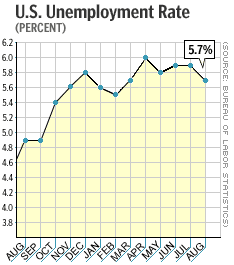NEW YORK (CNN/Money) -
New weekly claims for jobless benefits in the United States fell last week, the government said Thursday, staying just above the benchmark 400,000 level as the labor market struggled to recover from heavy job cuts last year.
The Labor Department said the number of Americans filing new claims for unemployment benefits fell to 406,000 in the week ended Sept. 21 from a revised 430,000 the prior week. Economists, on average, expected 420,000 new claims, according to Briefing.com.

"This is a welcome surprise; the trend in claims in recent weeks has been strongly upwards," Ian Shepherdson, chief U.S. economist at High Frequency Economics Ltd., said in a note.
It was the fifth straight week in which the number of claims exceeded 400,000, a benchmark level indicating weakness in the labor market.
In a separate report, the Commerce Department reported that orders for goods made to last three years or longer, such as cars and computers, fell 0.6 percent in August after rising a revised 8.6 percent in July. Economists expected durable goods orders to fall 3.4 percent, according to Briefing.com.
The reports helped lift U.S. stock market futures, pointing to a positive opening on Wall Street. Treasury bond prices fell.
In the Labor Department report, the four-week moving average of new jobless claims, which smoothes out fluctuations in the weekly data, dipped to 419,000 last week from a revised 420,000 the prior week.
| Related stories
|

|
|
|
|
Continued claims, the number of people drawing benefits for more than a week, rose to 3.68 million in the week ended Sept. 14, the latest data available, from a revised 3.59 million the prior week.
Earlier this month, the Labor Department reported that the nation's unemployment rate dipped to 5.7 percent, news that cheered some on Wall Street but was received skeptically by some economists.
Most economists think unemployment -- which is a lagging economic indicator, often rising even as the economy improves -- could rise above 6 percent before the labor market fully recovers.
U.S. businesses cut more than 1.5 million jobs during a recession that began in March 2001, and lately have been able to get more production out of fewer workers, making them reluctant to increase hiring until they see a need to greatly expand production.
Thursday's report on durable-goods orders showed a second straight monthly gain in orders for non-defense capital goods, an indication that businesses are spending again, which could mean they are preparing to increase production, which could lead to more hiring.
On Tuesday, the Federal Reserve decided to leave its target for short-term interest rates alone, though two members of the central bank's policy making committee urged a rate cut in response to recent signs of economic weakness.
The Fed cut its target for short-term rates 11 times in 2001 to lower the cost of borrowing and boost consumer spending, which makes up about two-thirds of the total economy. The low rates helped consumers shake off the job cuts, falling stock prices, terror attacks and more.

|

